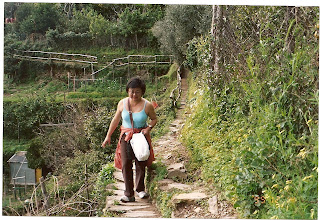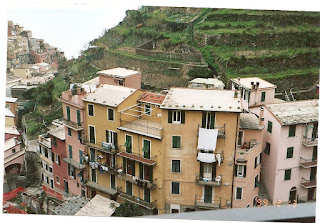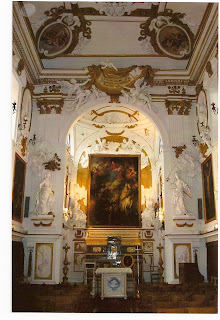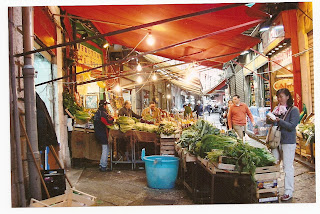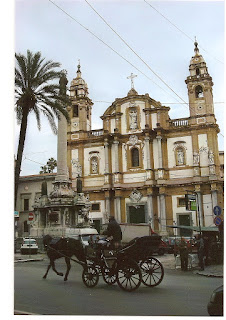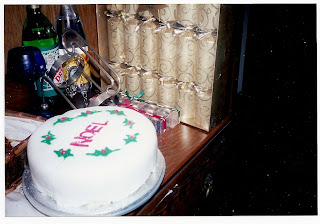

It seems a long time ago but it was only 2 years ago when I was training to walk the pilgrimage to Santiago de Compostela in Northern Spain. I wasn't going to walk the whole 500 miles because of time constraint. To earn a pilgrim award, one need only walk at least the last 60 miles which happens to be from a little called Saria to Santiago de Compostela. I was planning to walk that last 60 miles, takes about 5-6 days. This desire to go and perform a pilgrimage started 3 years ago when my sister visited Santiago de Compostela and developed a strong urge to tackle the journey. She talked incessantly about the glorious cathedral at Santiago de Compostela. Not to be outdone by her (we both have very competitive spirits) I decided to read about the pilgrimage. I begun to accumulate every book written on the camino. I checked the official website everyday for any morsel of the latest news; about the weather there, of the various celebrities who has gone there, including the crown prince of Spain and his wife and of the various low cost flights that fly there. I joined the American pilgrims on the road and the St James confraternity. These are various organizations associated with promoting the camino. The St James confraternity is the society of pilgrims out of Great Britain. I am still members of both and still receive their newsletters.
Before I knew it, I developed a strong urge to perform my pilgrimage and started to train for it. I started outfitting myself for the trip, an expensive backpack, water bottles, a hat, hiking boots and the whole kit and kaboodle which was not cheap.
In the original days of the camino whenever the need arises, one just take off and go. There are 3 important places to which pilgrims go to. Each is considered a holy and venerated site, its 'holiness' level depends on their association with Christ, the closer the holier. Christians believe that a consecrated place has sacred powers, powers to grant that which the pilgrim is seeking. There are lots of ancient books written about the reasons to take a pilgrimage, how to do it, where to go and the prescribed routes that would wend their way practically all over Europe, passing through churches and monasteries along the way where with a little money, the pilgrims could gain more comfort on the trip. It became a money making proposition for the church. Even though a lot of pilgrims were poor, there were richer pilgrims and even famous people and heads of states. The three important places of pilgrimage are the Holy land, Rome and Santiago de Compostela. After the failure of the crusades, it was near impossible to go to the Holy land. The purpose of the crusades was to protect the Holy land and make it safe for pilgrims. Then the next place to go was Rome but there was a period in Rome's history when it was dangerous to go to Rome, so then the pilgrims went to Santiago de Compostela in Spain. Pilgrims would come from all over Europe to a little town in the Pyrenees called St Jean pied de port, climb over the Pyrenees and onward to Santiago de Compostela through almost all of Northern Spain. It is in St Jean pied de port that the Pyrenees is the lowest in height and the easiest to cross. The Pyrenees is the mountain range that forms the natural boundary between France and Spain.
The cathedral at Santiago de Compostela was associated with St James, the apostle. He was said to have made missionary journeys to Spain. Jesus' great commission to 'preach the gospel to the ends of the earth' was take with great seriousness and enthusiasm. St Paul, as recorded in the book of 'Acts of the Apostles' speak of going to Rome and from Rome, with the assistance of the Christians in Rome, hoped to embark on missionary journeys to Spain. Presumably they thought that the north west corner of Spain was the 'end of the earth'. After that it was the Atlantic ocean and the end of the land mass. St Paul spent 2 years under house arrest in Rome and was then martyred. It was then presumed that James went to Spain and upon returning to Jerusalem after one of these trips was beheaded by Herod, the date recorded in the Acts was the year 44AD.
The legend started with the death of St James. Some of his followers took his body, put it on a boat for Spain and some how the boat got washed up on the shores near Santiago de Compostela. He was buried there and for a long time he was forgotten. His body and memory of him was later retrieved and a cathedral was built in his name. He became the patron saint of Spain and was credited with helping Spain drive out the Moors. Some pictures depict him as a warrior on a white charger and was given the name 'Santiago, matamoros' or James he Moorslayer'.
Pilgrims, then and now, were supposed to carry only what they need with them on this arduous journey. There are a few prescribed routes from all over Europe but most of them converged on St Jean pied de port for the climb up and down the Pyrenees and onward across the whole of Northern Spain to the cathedral at Santiago de Compostela. There are villages along the way and refuges set up to accomodate pilgrims. One could stay for one night for a small donation. These would be staffed by volunteers, people who had been pilgrims before.
For 5 months I trained for the camino. I was to fly to Santiago de Compostela, take the bus to Saria and then walk the 60 miles back to Santiago de Compostela. I was ready to go but 3 weeks before the day of departure, a call from my sister (another sister) changed my mind. She was afraid for me, afraid that I might not come back. It was very lame. She begged that I did not go. So I did not perform my pilgrim. My sister said, 'you've already performed the pilgrim, you've walked during your training, albeit not in Spain'. In a sense, yes, I've already walked. What was the object of the doing the camino? I can't remember. I know I have a lot of issues to work out about my work but how would walking a pilgrimage work out these issues? Today I have accepted and am working in spite of these unresolved issues. I know a lot of people perform pilgrimages to resolve issues in their lives. How, I don't know. Jesus did say, 'it will be done to you as you believe'.
Since I couldn't change my flight plans, I did go to Santiago de Compostela, I didn't walk but took the train across Northern Spain to France. I changed my itinerary. In Santiago, I saw pilgrims come in, more overwhelmed and tired than joyful. I don't know when the joy set in. After completing their camino, the thought on their minds is probably a long hot bath, a good substantial meal and how the heck to get out of there and go home. Then the scramble for train tickets and plane tickets to get home from whence they started and back to reality, hopefully with a changed heart and a renewed spirit. Does that really happen? Only if one is able to leave a lot of baggage along the camino. The baggage of intolerance, lack of a loving and kind spirit, fearfulness and a competitive spirit. All these things bog us down and shut out the spirit of joy. Does one need to walk 500 miles to do that? Does walking 500 miles bring joy to our lives?
After visiting the cathedral I took the long train ride to Hendaye in France and then onward to Bayonne. From Bayonne I took the 'pilgrim' train to St Jean pied de port, the starting point of the camino. There were at least 2 dozen pilgrims on the train, some in groups, others were alone. In 28 days or so, they hope to be seeing the steeples of the Gothic cathedral in Santiago de Compostela.
At the pilgrim office in St Jean pied de port, there was solemn excitement as the pilgrims seek out information about their camino. It was raining and it sort of dampened the excitement, reminding pilgrims of inclement weather on the trail. For solemn, I mean, it is not a walk in the park, there is a lot between St Jean and Santiago besides 500 miles. There is a lot of walking, blisters, hunger, thirst, fatigue and loneliness. From what I can see their packs were too heavy. They'll soon realize it. I walked the first 100 yards up a steep hill of the Pyrenees. I saw the markings of both the camino and the markings of the GR65. I was out of breath. It is a long climb up the Pyrenees and down into Roncevalles in Spain and then onward through muck, mud and whatever else.
I went and prayed in the cathedral in St Jean. I stayed a while in town before heading back to Bayonne. There were a few pilgrims on this train. Not everyone end up happy in Santiago. Some suffers injury and other ailments that forces them to abandon their pilgrimage and to turn around to head home at the starting gate. They look absolutely forlorn.
I don't think I can change by performing a pilgrimage. I don't think by walking I'll lose the part of me that holds back my joy and contentment. I think I'll change by taking up the cross of Christ daily, by being crucified with Him, by crucifying the self daily. I would lose in me the things that are better lost ie self righteousness that leads to much pain, pride and suffering.
For the while when we are on the pilgrimage, we will lose ourselves to the rhythm of the camino and forget our troubles but they come rushing back when we get home. But by taking up the cross daily, we are given 'new mercies' each day which enables us to continue victoriously through life. Though the deluge comes at us, we will not be drowned. Though we pass through the fires of life, it would not cinch us. The blood of the 'lamb' protects us and the angel of death passes over.
Would I attempt it again later? I don't know.




 The pictures of the Japanese Anemone are taken at a house in Venice beach, Ca, I don't know whose is it. I walk past it every time I walk to the beach. Each year around this time they bloom and give this glorious display. It is not so spectacular this year because the owners neglected them this year. In previous years the display were so awesome, I had wanted to take photos of it but missed the opportunity. I had to wait one whole year till yesterday for these 2 photos. They are still marvelous. My tomatoes had a good run, I gave a lot away and I ate a lot. I'm cleaning the yard today and will dispose them to the green can for recycling. It has been a great year and it is now winding down, not really, I leave for Sicily and Provence in a little more than 2 weeks. When I return preparations for the holidays starts.
The pictures of the Japanese Anemone are taken at a house in Venice beach, Ca, I don't know whose is it. I walk past it every time I walk to the beach. Each year around this time they bloom and give this glorious display. It is not so spectacular this year because the owners neglected them this year. In previous years the display were so awesome, I had wanted to take photos of it but missed the opportunity. I had to wait one whole year till yesterday for these 2 photos. They are still marvelous. My tomatoes had a good run, I gave a lot away and I ate a lot. I'm cleaning the yard today and will dispose them to the green can for recycling. It has been a great year and it is now winding down, not really, I leave for Sicily and Provence in a little more than 2 weeks. When I return preparations for the holidays starts. 




